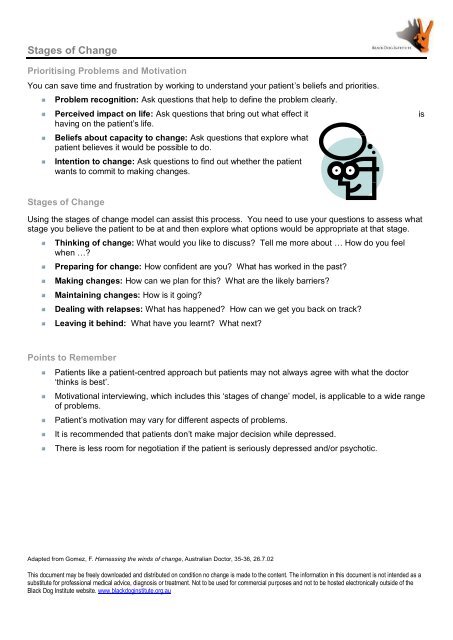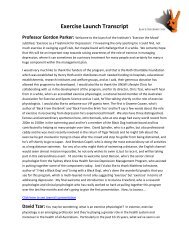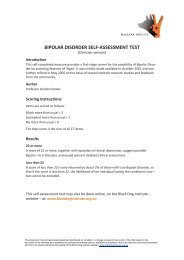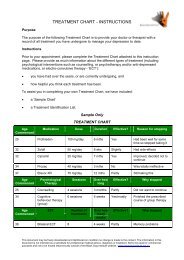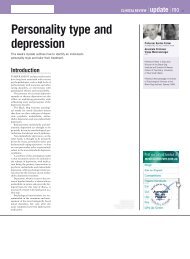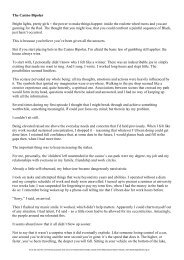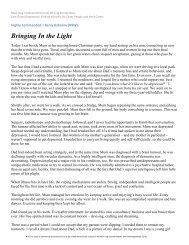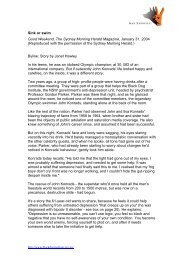Change - Black Dog Institute
Change - Black Dog Institute
Change - Black Dog Institute
You also want an ePaper? Increase the reach of your titles
YUMPU automatically turns print PDFs into web optimized ePapers that Google loves.
Stages of <strong>Change</strong>Prioritising Problems and MotivationYou can save time and frustration by working to understand your patient’s beliefs and priorities.Problem recognition: Ask questions that help to define the problem clearly.Perceived impact on life: Ask questions that bring out what effect ithaving on the patient’s life.Beliefs about capacity to change: Ask questions that explore whatpatient believes it would be possible to do.Intention to change: Ask questions to find out whether the patientwants to commit to making changes.isStages of <strong>Change</strong>Using the stages of change model can assist this process. You need to use your questions to assess whatstage you believe the patient to be at and then explore what options would be appropriate at that stage.Thinking of change: What would you like to discuss? Tell me more about … How do you feelwhen …?Preparing for change: How confident are you? What has worked in the past?Making changes: How can we plan for this? What are the likely barriers?Maintaining changes: How is it going?Dealing with relapses: What has happened? How can we get you back on track?Leaving it behind: What have you learnt? What next?Points to RememberPatients like a patient-centred approach but patients may not always agree with what the doctor‘thinks is best’.Motivational interviewing, which includes this ‘stages of change’ model, is applicable to a wide rangeof problems.Patient’s motivation may vary for different aspects of problems.It is recommended that patients don’t make major decision while depressed.There is less room for negotiation if the patient is seriously depressed and/or psychotic.Adapted from Gomez, F. Harnessing the winds of change, Australian Doctor, 35-36, 26.7.02This document may be freely downloaded and distributed on condition no change is made to the content. The information in this document is not intended as asubstitute for professional medical advice, diagnosis or treatment. Not to be used for commercial purposes and not to be hosted electronically outside of the<strong>Black</strong> <strong>Dog</strong> <strong>Institute</strong> website. www.blackdoginstitute.org.au
Stages of <strong>Change</strong>Decision-making Concerning <strong>Change</strong> to BehavioursSTAGE BEHAVIOUR APPROACHPre-contemplationNot thinking aboutchanging• Give relevant informationre. outcomes of makingchanges• Increase perception ofbehaviour• Prepare for changeContemplationSeriously thinking ofchanging but may beambivalent• Discuss reasons to change• Discuss pros and cons ofchanging or not changing• Set a change datePlanningPreparing for change• Consider assistance,where appropriate• Offer support• Discuss rewardsAction:Attempt at makingchanges• Encouragement• Seeing oneself acting outnew behaviourMaintenanceSustaining changesand ongoingmaintenance• Discussion of difficulties• Positive self-talk• Help identify strategies toprevent relapse• Ongoing supportRelapse prevention andmanagementorRelapseLeaving the behaviourbehind, moving on• Analyse a relapse• Do not treat relapse as afailure, but an opportunity• Give ongoing supportivecounselling to renewprocess of contemplation,determination, and actionNote:A worksheet which would be useful for a patient would be the ‘<strong>Change</strong> plan sheet’. This can be used toimplement the above stages with patients.This document may be freely downloaded and distributed on condition no change is made to the content. The information in this document is not intended as asubstitute for professional medical advice, diagnosis or treatment. Not to be used for commercial purposes and not to be hosted electronically outside of the<strong>Black</strong> <strong>Dog</strong> <strong>Institute</strong> website. www.blackdoginstitute.org.au


